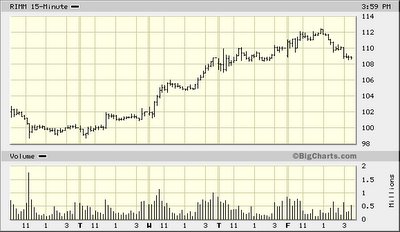A bull market as genuine as reality TV / fleckenstein
Research in Motion's jump in price is just more proof that some perspective is needed in this euphoric market.
Fact or fiction? A company makes forecasts that, arguably, are questionable. Initially, it doesn't produce its financials. It stages the whole production in a bizarre manner. And then, it's cheered wildly as its stock explodes upward 20%.
Just another reality show on Wall Street, featuring none other than Research in Motion
Putty in the hands of a grand puppeteer
The date was Sept. 28, and Research in Motion was slated to release earnings at 5 p.m. EDT. Typically, a company that's chosen this time slot will summarize its results about 45 minutes earlier. However, as 5 p.m. approached, not a peep had been uttered from RIM.
Folks assumed that delaying the financials that long couldn't possibly be good news. Which is why, in after-hours trading from 4 p.m. to 5 p.m., almost a million shares changed hands. Around 5 o'clock, RIM announced that its conference call wouldn't occur until 5:15. Shortly thereafter, the company disclosed that it had an options-backdating issue. (who cares these days....http://immobilienblasen.blogspot.com/2006/09/options-complacency-broadcom-brcm.html)

(so sieht ein cahrt von ner frima aus die keine bilanzen erstellen kann und denen masive berichtigungen wg. der zurückdatierten optionen ins hause steht/ raelly looks like a chart where tehy comp. is unable to file its financial statement and where the options are backdatet. complacency everywhere)
As that was released, the numbers for the quarter came out -- only a bit better than had been expected -- and in the blink of an eye, the stock was trading at $80, down about $6. But then came a forecast of a large increase in revenues for next quarter (sans balance sheet, income statement and other details), despite the fact that in the previous 10 consecutive quarters, the maker of the BlackBerry device had reported a slowdown in its rate of growth in the face of the serious competition now in the marketplace.
Lo and behold, the stock exploded into the $90s, before finishing that night around $102 and change.
Amnesia for fun and profit
The company's timing was most curious. Do you mean to tell me that it didn't know until sometime after 4 p.m. on the night in question that it potentially had an options-backdating problem, and consequently its financials would be delayed? (Sometime after the conference call, RIM released its financials -- which showed inventories up 133% year-over-year and receivables up 62% on a revenue gain of 30%. That made its "beating the number" look even more dubious.)
But why bother asking such a question? After all, Wall Street has to keep its priorities straight -- which it did last week when launching the Dow to a new high. Not to rain on this "achievement," but some perspective is warranted. For that, I'll turn to two longtime market observers, Justin Mamis and Dennis Gartman, whose comments buttress the views I shared last week regarding 1973.
Chinks in the charts
In a recent letter, Mamis noted how sloppy the breadth of the rally has been and how many failures can be seen on various stock charts. Which prompted him to ask: "With all these failures, is there some secret significance to the DJIA making a higher high?" Even within the Dow, Justin observed, the advance has been narrow.
More importantly, he said: "We never realized we'd have to keep track of such matters, but this must be the worst set of statistics ever assembled on a day that the Dow Jones Industrial Averages excited 'everyone' by making a new high. (Well, we don't know what the statistics would have been at the 1929 peak, but we don't think that the 1987 numbers were as glaring.)"
Hex on an apex
In a similar vein, Gartman said: "The dancing, whooping and celebration on the various business television channels regarding the new 'all-time high for the Dow' was utter and complete nonsense.
"It seemed to us all too reminiscent of the top made in the autumn of 1973, when the Dow forged a new high by the barest of margins and then proceeded to follow the other indices lower, in a devastating bear market that ended in the summer of 1974 when the Dow was half what it had been months earlier, amidst the euphoria."
Manic, but mortal
Those two seasoned commentators feel as I do: that what we are seeing is more of an exhaustion gasp than the start of anything new. That said, when things get this crazy, they can easily get far crazier.
So, there is no timing data in those observations. Exhaustion can't be predicted in advance. Exhaustion can only be deduced once it's occurred (though even that requires some guesswork).
Talking-head
alertLast Wednesday, I was interviewed by a longtime buddy, Lee Adler. And while you're at it, check out his Web site.
jan-martin
![[Most Recent Quotes from www.kitco.com]](http://www.kitconet.com/charts/metals/gold/t24_au_en_usoz_2.gif)
![[Most Recent Quotes from www.kitco.com]](http://www.kitconet.com/charts/metals/gold/t24_au_en_euoz_2.gif)

0 Comments:
Post a Comment
<< Home